End U.S. Support for Israel! End the Occupation Now!
• Palestinians Mark Nakba Day by Demanding Their Right to Return
• New Orleans Delegation Heads to Gaza • Seventh Annual International Al-Awda — Palestine Right of Return Convention
•
The Old Still Live Through Us, the Young Will Never Forget • War Crimes Against Palestinian Children • Billions Promised, but Gazans Still Waiting
•
Resistance to Continued Blockade of Gaza
End U.S. Support for Israel! End the Occupation Now!
Palestinians Mark Nakba Day by Demanding Their Right to Return
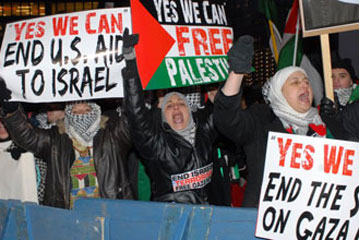
![]()
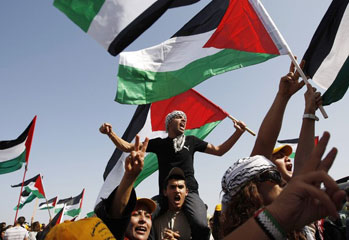
Demonstrators defend Palestine, left, Chicago, and right in Palestine on Nakba Day, 2009
Tens of thousands of Palestinians in the occupied West Bank, Gaza and Lebanon marked Nakba Day May 15 with rallies and various actions emphasizing the right of all Palestinians to return to Palestine and defending Palestine’s right to be. The Nakba — or the “catastrophe” of Israel’s inception — is marked with actions worldwide as well, as Palestinians step up the struggle for their rights and the world’s peoples stand with them. Voice of Revolution salutes the Palestinians and joins them in demanding End the Occupation Now! Right of Return for all Palestinians!
President Barack Obama will be meeting with Israeli Prime Minister Benjamin Netanyahu May 18. In the past, these meetings have been a prelude to more intense Israeli attacks on Palestine. We demand that Obama be true to his words of change by implementing the deed of ending military and economic funding for Israel. Such actions are needed to bring change in the current situation.
Palestinians are making clear that they will continue to resist. At various actions in Palestine, large keys will be used in demonstrations to symbolize the demand of Palestinians to return to their homes, and that the right of return is integral to any resolution of the U.S.-Israeli occupation of Palestine.
In Gaza, thousands demonstrated for unity and resistance. Abdul Latif Qanu, the spokesman of Hamas in northern Gaza, said that the Nakba anniversary is an opportunity to affirm the right of return for six million Palestinian refugees forced out of their homeland. In a statement May 14, Qanu said that the return of Palestinian refugees to their hometowns is inevitable despite all attempts to negotiate that right. Surrendering the right of return is high treason and all attempts to abandon that right were aborted by the Palestinian people’s blood and would not succeed, Qanu elaborated. Hamas would never give up the right of return, the spokesman said, saying Hamas remains steadfastness on Palestinian rights. He called on the Palestinian people in Gaza to participate in the Nakba demonstrations.
During a rally organized in the occupied West Bank city of Nablus, the name of the square located between the Balata and Askar refugee camps was renamed “The Return Square. “ Similar rallies were held in Jenin, Tulkarm and other cities as Palestinians defend their national and social rights. Speakers everywhere stressed that the right of return was undeniable and must be implemented as part of any future agreement.
In Akko, currently part of northern Israel in the Galilee, Palestinians will march on May 16 in honor of Nakba Day. Their slogan is “Not Another Nakba.” They plan to carry black flags and torches. Organizers report that “The most important message to give our youth is to be vigilant, so there will not be another Nakba.”
Voice of Revolution demands that the U.S. immediately end all funding and support of Israel as the concrete action needed to end the occupation and provide conditions for peace in the region.
Long Live the Palestinian Resistance! Defend the Right of Return!
[TOP]
New Orleans Delegation Heads to Gaza
On May 29, a group of New Orleans social justice activists, filmmakers, photographers, and journalists will attempt to cross the Rafah border into Gaza. We will be joining a CodePink delegation that is bringing medical supplies, playground equipment, and toys to Gaza — the 140 square mile open-air prison recently devastated by the Israeli siege called “Operation Cast Lead.” More than 1,400 Palestinians, including more than 300 children, were killed in the siege between late December and mid-January. The people of Gaza are still suffering from serious food and water shortages, grossly inadequate medical services, and the utter devastation of the civilian infrastructure in this already impoverished and brutalized region. Many of the struggles we take on here in New Orleans are seen even more extremely in Gaza, such as racism, the cradle-to-prison pipeline, the right to return, the right to housing, and the right to healthcare. We in New Orleans have a special insight into a number of the struggles Gazans and all Palestinians face, and for this reason we hope you will support us in this effort.
We are going to Gaza to express our solidarity and to photograph, film, and write about the reality of Gaza, so that when we return we can share our experiences with our communities and build solidarity in the struggle for liberation and self-determination for Palestinians, New Orleanians, and all people. We will be traveling with an incredible team of journalists, award-winning filmmakers and photographers, a children’s book author, social workers, development experts, and public health professionals.
So far we have already begun planning two documentaries, a theatrical performance, and a photography exhibition. This trip to Gaza, and the media we produce, are important steps in supporting the long-term struggle for a free Palestine.
We hope you will consider supporting us in several ways:
1. Monetary donations are invaluable to our delegation, and the postcards we send and gifts and photographs we bring back are a small token of our immense gratitude for your support.
2. Supplies and gifts for the people of Gaza: Because the border between Egypt and Gaza is almost always closed except for a trickle of supplies and international delegations, it is crucial that we use this opportunity to bring medical supplies, toys, coloring books, and other necessities in with us. Cash donations are best (see above), as the items we would like to bring to Gaza are cheaper to purchase in Cairo. But if you have brand new items that you would like to donate, especially over-the-counter medicine and school supplies for children, please email emily@nolahumanrights.org. Please remember that we have to travel light, and so heavy and bulky items may be difficult for us to bring, but we hope to bring as much as we can.
3. Letters, photographs, and other signs of solidarity: We want to show the people of Gaza that New Orleans is thinking about them, and has not forgotten their struggles. Letters and photographs are light and easy to carry, and are invaluable gifts of hope for the people we will meet. Please email emily@nolahumanrights.org if you or your organization would like to send a symbol of solidarity with the delegation.
[TOP]
Seventh Annual International Al-Awda —
Palestine Right of Return Convention
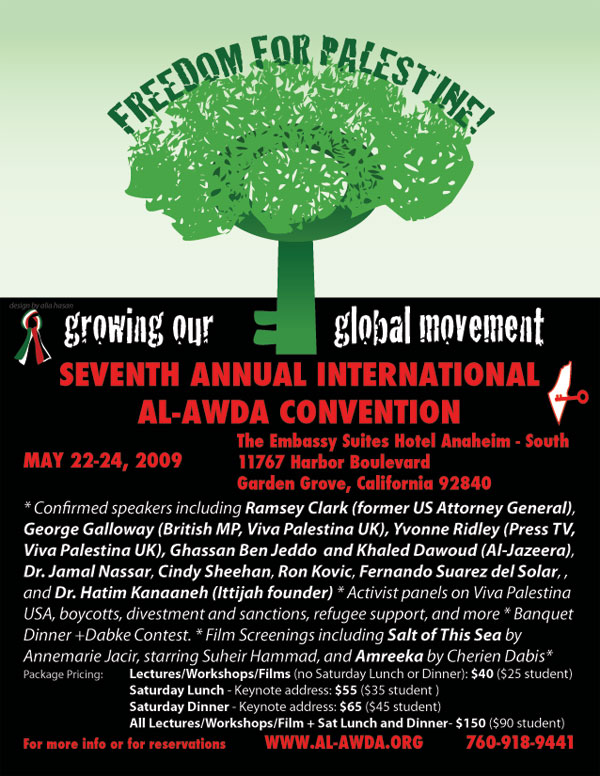
[TOP]
The Old Still Live Through Us,
the Young Will Never Forget
On July 18, 1948 Israeli Zionist David Ben-Gurion wrote in his diary: “We must do everything to ensure they (the Palestinian refugees) never do return…. The old will die and the young will forget.”
Today, 61 years after the Nakba of 1948 and despite the on-going Zionist terror and ethnic cleansing, we are still here and we have not forgotten, nor will we ever. In 1948/49, accompanied by looting, pillage and plunder, 418 Palestinian localities, including towns, villages and tribes, were destroyed by Zionist terror groups, the predecessors of the Israeli Occupation Forces. A study by researcher Salman Abu Sitta lists 531 destroyed localities and 11 emptied urban neighborhoods. Many villages were completely erased off the face of the earth, while others stand in ruins today. The inhabitants of these villages were faced with massacres and forced expulsion, and Palestinian houses, belongings and lands were usurped. Seventy massacres left 15,000 Palestinians dead and up to 850,000 Palestinians were made refugees.
The Zionists did not spare those living peacefully on their lands nor the dead lying peacefully under their lands. Graves were desecrated, dug and destroyed. Knowing they were stealing something that did not belong to them, and as if fearing that even the dead would wake up one day and demand justice and their homes back, they wanted to erase every trace of its real owners, including the graves. Palestinian towns and villages were given Jewish names to hide their Palestinian origin, new Zionist colonies were built on the ruins of many of them and resettled by Zionists coming from Europe and elsewhere and who had no right to Palestine and its lands.
Addressing the Technion (Israel Institute of Technology) in Haifa in 1969, Moshe Dayan said: “Jewish villages were built in the place of Arab villages. You do not even know the names of these Arab villages, and I do not blame you because geography books no longer exist. Not only do the books not exist, the Arab villages are not there either. Nahlal arose in the place of Mahlul; Kibbutz Gvat in the place of Jibta; Kibbutz Sarid in the place of Huneifis; and Kefar Yehushua in the place of Tal al-Shuman. There is not a single place built in this country that did not have a former Arab population.”
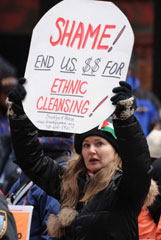 Israelis and others, using Sderot as an excuse for Israel’s war crimes in Gaza, should remember where it stands, on the ruins of which Palestinian town, on the ruins of whose houses. Sderot was built on the remains of the Palestinian village Najd, which like other villages was ethnically cleansed before being erased from today’s world map. A map created by a biased world, which even after 61 years of on-going ethnic cleansing could not bring itself to shed its bias and take action. But these villages still stand in our maps because we did not forget.
Israelis and others, using Sderot as an excuse for Israel’s war crimes in Gaza, should remember where it stands, on the ruins of which Palestinian town, on the ruins of whose houses. Sderot was built on the remains of the Palestinian village Najd, which like other villages was ethnically cleansed before being erased from today’s world map. A map created by a biased world, which even after 61 years of on-going ethnic cleansing could not bring itself to shed its bias and take action. But these villages still stand in our maps because we did not forget.
The original residents of these and other Palestinian towns and villages and their descendants, ethnically cleansed from their homes, are scattered all over the world. Today, there are more than 7 million displaced Palestinian, constituting the world’s largest displaced population. On the Sixtieth Anniversary of the Nakba in 2008, the Palestinian Central Bureau of Statistics (PCBS) issued a special report stating that Palestinians worldwide have multiplied 7.5 timers since the Nakba of 1948. While there were 1.4 million Palestinians in Palestine in 1948, there were some 10.6 million Palestinians worldwide in 2008, half of which are refugees. About 3.76 million Palestinians live in the Occupied Palestinian Territories and 44.6 percent are refugees. […]
One of my favorite songs as a child was a song aired on Syrian TV. Little children singing: “my country is very beautiful” while painting and playing with small toy houses. The song goes on: “Do you know what happened? In 1948 they took everything. They burned the room, and they broke down the houses. They uprooted the forests and erased the whole village, and they changed the names.” The children then gather the destroyed houses and tree figures and place them in boxes and sing that the chests have remained in their hearts, with them grandmother’s tales, mother’s tales, grandfather’s proverbs and father’s bequests. The song ends with “My country is still beautiful, my country is called Palestine.” And then, one child after the other says his/her name and where they come from. It is clear that these are Palestinian children living in refugee camps either in Syria or Lebanon, but even the youngest of them know they come from a small village in Palestine.
As in the song, Palestinians worldwide carry the “chests from Palestine” in their hearts and with them their national and cultural identity as Palestinians. This is not exclusive to Diaspora Palestinians. My cousins in Dheisheh Refugee camp, their friends and other kids from the refugee camp know how it feels to be at home and not yet at home. Although they live in Palestine, they are not in their original villages. When asked where they come from, they would say: from Jrash, from Zakariya, from Dayr Aban, etc…. Their answer would be full of confidence and pride, and would come quick and natural, because there was nothing there to think about: “My home is Jrash, I am here on a temporary basis.” Not only do they know that these villages are their one and only home, these villages are part of what they are: in addition to the family name Ramadan or Salem, today they are also known as Jrashi (from Jrash) or Derabany (from Dayr Aban) or ‘Ajjuri (from ‘Ajjur).
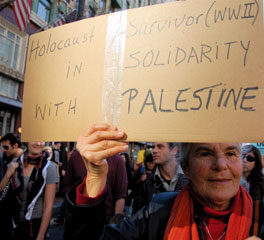 The Zionists see themselves as the ultimate victims. They refuse to accept any comparison between the Holocaust and any other human catastrophe. They insist that their suffering is the ultimate suffering, as if suffering can be measured by the kilo or the liter. Every cry of a child, every agony, every death counts, and is a human suffering. And if they measure their “ultimate suffering” with the atrocities committed by the Nazis, then they better look closely at their own state and their own deeds, for there is only one reflection to see. What they are, other than the “ultimate murderers” and “the ultimate racists,” are the ultimate thieves, and Zionism not only incorporates terror but the ultimate theft. They not only stole another peoples’ land, they are stealing their culture as well. […]
The Zionists see themselves as the ultimate victims. They refuse to accept any comparison between the Holocaust and any other human catastrophe. They insist that their suffering is the ultimate suffering, as if suffering can be measured by the kilo or the liter. Every cry of a child, every agony, every death counts, and is a human suffering. And if they measure their “ultimate suffering” with the atrocities committed by the Nazis, then they better look closely at their own state and their own deeds, for there is only one reflection to see. What they are, other than the “ultimate murderers” and “the ultimate racists,” are the ultimate thieves, and Zionism not only incorporates terror but the ultimate theft. They not only stole another peoples’ land, they are stealing their culture as well. […]
But one thing they forgot: they can — for now — steal the land, the culture and forge history, but they cannot delete our memory nor forge the blood that flows in our veins. One afternoon, back in 1982, my sister, brother, some friends and I, decided to have a picnic. At school, we used to do this often. All we would need would be some slices of bread, a couple of tomatoes, and some salt in a paper. During the second break, which lasted some 20 minutes, we would have our picnic in one corner of the school playground. On that afternoon, we planned to have the picnic with our friends after we got back from school the following day. We were very enthusiastic, because our friends did not know what a “picnic” was and we wanted to share that with them. That evening, when we told our parents about our plans, father said: no, there will be no picnic tomorrow.
For me, that was one of those days that remain branded in one’s mind for ever, memories of what we Palestinians should never ever forget and never forgive. On TV, we saw the pictures of butchered Palestinians, piled up like sacks one over the other. We saw pictures of murdered women, children and elderly filling the streets. We saw women crying and shouting and cursing. We saw what had happened in Sabra and Shatila [Palestinian refugee camps were thousands of civilians were massacred].
It was like waking up from a dream, and realizing that for you, as a Palestinian, there was no place for picnics, no place for happiness when other Palestinians are being murdered. These Palestinians were not in Palestine, they were far away from us, but they were part of us. They were a part that makes Palestine full, for Palestine belongs to all Palestinians, and when Palestinians bleed, whether in Palestine or in the Diaspora, Palestine as a whole bleeds. More massacres and Israeli crimes followed, and with every massacre, with every crime, with every war, we stood together as one. We cried for every child, we went to the streets for every martyr and every wounded and every prisoner, we protested and made our voice heard. It is our unity that makes us strong, a blood bond that not Israel, not the U.S., can break.
Despite their Nazi-like methods, Zionists continue to deny it and shout anti-Semitism when accused of it, although a number of Zionists had as early as 1948 realized and admitted they were acting like Nazis towards the Palestinians. Aharon Cizling of the 1948 Israeli cabinet commented on reports of Israeli war crimes against Palestinians: “… But now Jews too have behaved like Nazis and my entire being has been shaken … Obviously we have to conceal these actions from the public, and I agree that we should not even reveal that we’re investigating them.” […]
Times change and mass murderers develop their gas chambers to fit the times. Instead of killing millions in a few months and drawing world uproar, why not kill gradually? Every couple of years a war here and an incursion there, wiping out thousands and leaving thousands crippled. Every now and then an air raid here and there, leaving dozens killed and hundreds other crippled. And why not use checkpoints, peaceful demonstrations and the siege to kill an extra few here and there? The problem here is that with every Palestinian killed, at least 10 others are born, and with every massacre committed, our roots in the land get deeper and our memory gets stronger.
So, although after 61 years of an on-going Nakba, an on-going ethnic cleansing and terror, we are scattered everywhere, one thing binds us: our Palestinian identity, the place we all call home, the home we all want to return to. No matter what nationality some of us have today, or where we were born, as long as Palestinian blood flows through our veins, we have one nationality and one homeland: Palestine.
[TOP]
New Report on the 313 Children Killed During U.S.-Israeli Gaza Offensive
War Crimes Against Palestinian Children
A new report released May 14 reveals the true extent of child killings by Israeli forces in the Gaza Strip during its 23 day offensive against Gaza between December 27, 2008 and January 18, 2009.
The Palestinian Center for Human Rights (PCHR) is publishing War Crimes Against Children in response to the unprecedented number of children killed by Israeli forces in its latest operation — a total of 313 children under the age of eighteen. Containing numerous eyewitness testimonies, the report brings to light Israel’s widespread targeting of unarmed civilians, including children, throughout the offensive.
“Operation Cast Lead” was the biggest Israeli military operation in the Gaza Strip in nearly 42 years of occupation. 1,414 Palestinians were killed, and PCHR investigations have found the overwhelming majority, 83 percent, were civilians. One of the cases in the report is that of 18 month old Farah al-Helu, who was killed on January 4. The al-Helu family had been told to evacuate their house in Zaytoun, eastern Gaza, but while they were attempting to flee, Israeli soldiers opened fire on them. Farah was shot in the stomach and bled to death two hours later.
War Crimes Against Children exposes the abject failure of Israeli authorities to uphold internationalhumanitarian law, which provides protection for children in armed conflict and the lack of adequate precautions taken to distinguish between civilians and military targets. The report also details indiscriminate shelling of homes and schools where internally displaced people were sheltering, the psychological impact of the offensive, and the alarming scale of physical injuries inflicted on young people.
“We are calling for an independent full-scale investigation into all documented attacks on civilians during the offensive,” said Raji Sourani, director of PCHR. “Israel must be held fully accountable for the crimes it has perpetrated against Gaza’s civilian population, including alleged war crimes against children. We cannot allow the lives of these children to just be statistics in the history books of the Middle East.”
PCHR is calling on the international community to urge Israel to respect and uphold the human rights of Palestinians in the Occupied Palestinian Territory. “Urgent measures are needed in order to prevent further deaths,” added Mr. Sourani.
The Center is also recommending the urgent establishment of an independent committee to investigate the child killings. The committee must meet international standards of independence and transparency and publish its findings publicly.
[TOP]
Billions Promised, but Gazans Still Waiting
It has been four months since the U.S.-Israeli bombardment of Gaza. In March, an international conference to secure aid promised $5.2 billion to rebuild Gaza. But the U.S. is making sure the funds do not reach Gaza. The U.S., mainly responsible for the carnage, while funding and protecting Israel, pledged a paltry $900 million. Food aid is slowly getting into Gaza, but even that the Israelis are trying to block. They recently bombed the tunnels used by Gazans to bring in food and other supplies from Egypt. But reconstruction cannot begin as construction supplies are completely blocked. At least 14,000 homes throughout the Gaza Strip were destroyed or badly damaged, according to the UN Development Program. Infrastructure, such as roads, water, sewage and electricity supply, were severely affected.
The U.S. is making certain that no international aid is allowed into Gaza, as they refuse to recognize and work with the elected government there — Hamas. Indeed, Clinton said “not a cent” would be given if Hamas was in any way involved. Israeli Prime Minister Benjamin Netanyahu ordered a review of the policy of barring construction materials from Gaza, but the ban still remains in place. Echoing the U.S., according to officials in Netanyahu’s office, “Keeping the money out of the hands of Hamas is a challenge,” says one Israeli official. “Whether the money is dollars, Euros or shekels, no one has easy answers.”
Netanyahu will be meeting with President Barack Obama May 18, where both are expected to insure more crimes are committed against the people of Gaza.
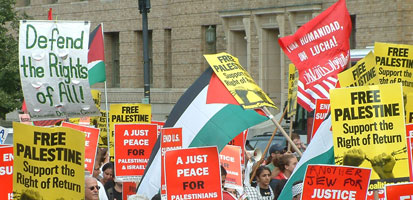
[TOP]
Resistance to Continued Blockade of Gaza
UN agencies report that economic recovery in the Gaza Strip is being stopped due to Israel's ongoing blockade of cash, materials and spare parts following its brutal Cast Lead operation in late December. The UN Office for the Coordination of Humanitarian Affairs (OCHA) noted that the ban which prohibits importing construction supplies has also stalled major repairs on Gaza's schools after the operation launched last December, many of which were directly targetted by Israeli Occupation Forces during the assault. The attempt to isolate Gaza through prohibitions and restrictions on the entry of cash has delayed work on almost all of the 200 projects planned under the $615 million UN Flash Appeal for Gaza and its 1.5 million Palestinians residents, according to the OCHA. As of May 13, Zionist authorities were only partially opening crossings occasionally for delivery of limited food and animal fodder and the occasional truck of commercial goods, Ma'an news agency reports.
On May 9, Hamas Deputy Prime Minister Ziad al-Zaza indicated means are being found to deal with the situation and detailed the movement's plans to rebuild the massive number of houses destroyed using materials on hand: "In the next few days we will start using mud to rebuild the houses that the [Israeli] occupation destroyed in Gaza. This is a serious undertaking by the government to break the blockade imposed on the Gaza Strip."
The Hamas-run government is using blueprints approved by local municipalities and the union of Gaza engineers for three-story buildings that "would last for decades," Zaza said. According to Zaza, the program is beginning with the building of a three-story "model home" on 250 square meters (around 2,700 square feet) of land. The costs of the project are being covered by the government and local Palestinian aid groups. The program is creating employment including factories resuming activity, Zaza said.
OCHA's March report indicated that the continued blockade on the livelihoods of Gazans -- especially farmers, herders and fishermen -- has been exacerbated by Israeli restrictions on access to farmland along the border and to fishing areas beyond three nautical miles from the shore. For its part, the UN Development Program (UNDP) noted in April that unemployment in Gaza has risen from 36 percent before the military operations to 43 percent since the official end of Israeli military operations on January 28. Poverty among the unemployed has also increased from 56 per cent to 66 percent during the same time period, UNDP said.
In an April 18 item from the UN News Center, John Holmes, UN Under-Secretary-General for Humanitarian Affairs, addressed the issue of aid to Gaza being made on a conditional basis: "For the humanitarian situation in the Gaza Strip to improve, lifesaving assistance must be decoupled from the security and political agendas."
"If the Israeli-Palestinian peace that has been sought for over 60 years, and more recently inter-Palestinian reconciliation, remain preconditions for improving living conditions, the Gaza Strip risks being dependent on handouts for years to come," he warned, appealing for the reopening of all land borders to allow urgently-needed humanitarian and reconstruction supplies into Gaza.
In March at a donors conference in Egypt, over $5 billion was pledged for reconstruction efforts in Gaza, "possibly the most significant show of donor support for Gaza in the history of the occupied Palestinian territory," Holmes, who also serves as UN Relief Coordinator, said.
However, "for once, money is not the main problem," he noted, adding that the funds are not "hitting [the] mark" with three-quarters of Gazans requiring some form of aid.
In addition, a ban on exports, apart from a few truckloads of flowers, has exacerbated the situation by crushing Gaza's job-creation industries, said Holmes, referring to the blockade as a form of collective punishment.
The blockade and aftermath of the Israeli assault are also having a severe impact on the health of Gaza residents. An April 22 item from UN News Center reports that the UN Relief and Works Agency for Palestine Refugees in the Near East (UNRWA) warned the number of cases of acute watery diarrhea among children under the age of three have topped the alert threshold for the second time this year.
The agency added that test results released in March showed contamination in 14 percent of water samples, and expressed concerns that water could be further tainted by the residue of toxic munitions.
(Sources: UN News Center, Press TV, Ma'an News Agency)
